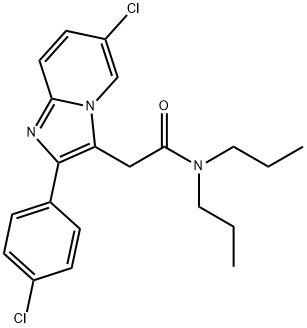Alpidem
Synonym(s):6-Chloro-2-(4-chlorophenyl)-N,N-dipropyl-imidazo[1,2-a]pyridine-3-acetamide;6-Chloro-2-(p-chlorophenyl)-N,N-dipropylimidazo(1,2-a)pyridine-3-acetamide;Ananxyl;SL 80.0342-00
- CAS NO.:82626-01-5
- Empirical Formula: C21H23Cl2N3O
- Molecular Weight: 404.33
- MDL number: MFCD00866978
- SAFETY DATA SHEET (SDS)
- Update Date: 2024-11-19 23:02:33

What is Alpidem?
Description
Alpidem is an imidazopyridine antianxiety agent with anticonvulsant properties. It is claimed to be the first non-benzodiazepine anxiolytic to show selectivity for the omega-1 modulatory site of the GABA, receptors. Alpidem is reported to be superior to buspirone and similar to the benzodiazepines, but is significantly better tolerated with lower abuse potential.
Chemical properties
White to Off-White Solid
Originator
Synthelabo (France)
The Uses of Alpidem
A peripheral benzodiazepine GABAA receptor ligand, a new anxiolytic
What are the applications of Application
Alpidem is a peripheral benzodiazepine GABAA receptor ligand and a new anxiolytic
Definition
ChEBI: Alpidem is a member of imidazoles.
brand name
Ananxyl
Biochem/physiol Actions
Alpidem is a potent antagonist of peripheral benzodiazepine receptor (PBR) that is located on the outer mitochondrial membrane and interacts with the mitochondrial permeability transition (MPT) pore. Alpidem is an anxiolytic drug from the imidazopyridine family. Alpidem acts selectively on the α3 receptor subtype and to a lesser extent at the α1 subtype (Kd of 0.33nM and 1.67nM respectively), of the benzodiazepine receptor.
Clinical claims and research
Alpidem is an imidazopyridine partial agonist that also shows relative selectivity for the type I benzodiazepine receptor. Studies have shown an anxiolytic effect comparable with the classic benzodiazepines, but with an improved adverse effect profile (Pancheri et al. 1993). It has also been compared with buspirone in patients with generalized anxiety disorder and shown to be more rapidly effective and again to have a more favorable adverse effect profile (Legris et al. 1993). Longer-term studies with alpidem have shown that tolerance does not occur, and no significant problems of withdrawal on discontinuation were found (Chevalier et al. 1993). Alpidem was licensed in France for the treatment of anxiety but has now been suspended because of recent reports of alpidem-induced hepatic dysfunction. The reason for this is unclear, but it may be a reflection of the fact that alpidem also binds to peripheral benzodiazepine receptors, which are present in high density in the liver.
Properties of Alpidem
| Melting point: | 136-138°C |
| Density | 1.24±0.1 g/cm3(Predicted) |
| storage temp. | Refrigerator |
| solubility | DMSO: ≥10mg/mL |
| pka | 4.74±0.50(Predicted) |
| form | powder |
| color | white to tan |
Safety information for Alpidem
| Signal word | Warning |
| Pictogram(s) |
 Exclamation Mark Irritant GHS07 |
| GHS Hazard Statements |
H302:Acute toxicity,oral |
| Precautionary Statement Codes |
P280:Wear protective gloves/protective clothing/eye protection/face protection. P305+P351+P338:IF IN EYES: Rinse cautiously with water for several minutes. Remove contact lenses, if present and easy to do. Continuerinsing. |
Computed Descriptors for Alpidem
New Products
Tert-butyl bis(2-chloroethyl)carbamate (S)-3-Aminobutanenitrile hydrochloride N-Boc-D-alaninol N-BOC-D/L-ALANINOL 3-(2,4-Dimethoxybenzyl)dihydropyrimidine-2,4(1H,3H)-dione 6-Bromo-3-iodo-1-methyl-1H-indazole N-octanoyl benzotriazole 3,4-Dibenzyloxybenzaldehyde 4-Hydrazinobenzoic acid Electrolytic Iron Powder 1,1’-CARBONYLDIIMIDAZOLE R-2-BENZYLOXY PROPIONIC ACID 4-HYDROXY BENZYL ALCOHOL 1,1’-CARBONYLDI (1,2-4 TRIAZOLE) S-2-CHLORO PROPIONIC ACID (2-Hydroxyphenyl)acetonitrile 4-Bromopyrazole 5-BROMO-2CYANO PYRIDINE 5,6-Dimethoxyindanone 5-broMo-2-chloro-N-cyclopentylpyriMidin-4-aMine N-Boc-L-proline methyl ester 2-(BOC-Amino)4-picoline 1-(4-Methylphenylsulfonyl)-1H-1,2,3-benzotriazole 1-(2-Chlorobenzyl)-4-nitro-1H-pyrazoleRelated products of tetrahydrofuran


![2-(4-CHLORO-PHENYL)-IMIDAZO[1,2-A]PYRIDINE](https://img.chemicalbook.in/CAS/GIF/38922-74-6.gif)
![Imidazo[1,2-a]pyridine-3-ethanamine (9CI)](https://img.chemicalbook.in/CAS/GIF/664367-52-6.gif)
![2-(2-PHENYL-IMIDAZO[1,2-A]PYRIDIN-3-YL)-ETHYLAMINE](https://img.chemicalbook.in/CAS/GIF/171346-87-5.gif)
![2-IMIDAZO[1,2-A]PYRIDIN-3-YLACETAMIDE](https://img.chemicalbook.in/CAS/GIF/21801-86-5.gif)
![6-CHLORO-2-PHENYL-IMIDAZO[1,2-A]PYRIDINE](https://img.chemicalbook.in/CAS/GIF/168837-18-1.gif)

You may like
-
 55441-95-7 2 2-BIS(2-HYDROXYETHOXY)-1 1-BINAPHTHYL 99%View Details
55441-95-7 2 2-BIS(2-HYDROXYETHOXY)-1 1-BINAPHTHYL 99%View Details
55441-95-7 -
 181228-33-1 99%View Details
181228-33-1 99%View Details
181228-33-1 -
 Ste-Glu-AEEA-AEEA-OSUView Details
Ste-Glu-AEEA-AEEA-OSUView Details
1169630-40-3 -
 1446013-08-6 Fmoc-His-Aib-OH TFA 98%View Details
1446013-08-6 Fmoc-His-Aib-OH TFA 98%View Details
1446013-08-6 -
 127464-43-1 99%View Details
127464-43-1 99%View Details
127464-43-1 -
 Chloro Uracil 99%View Details
Chloro Uracil 99%View Details
1820-81-1 -
 2-ETHYLPYRIDINE 100-71-0 99%View Details
2-ETHYLPYRIDINE 100-71-0 99%View Details
100-71-0 -
 13162-05-5 99%View Details
13162-05-5 99%View Details
13162-05-5